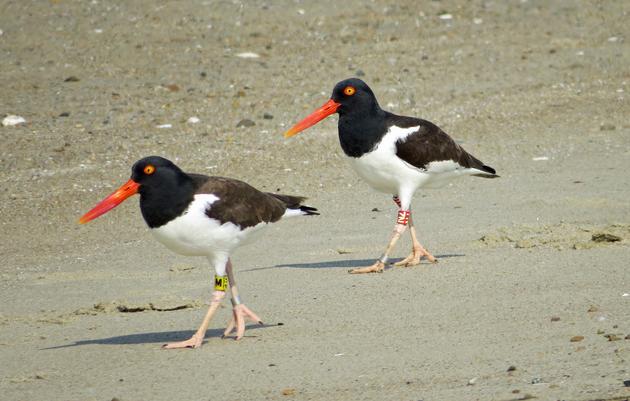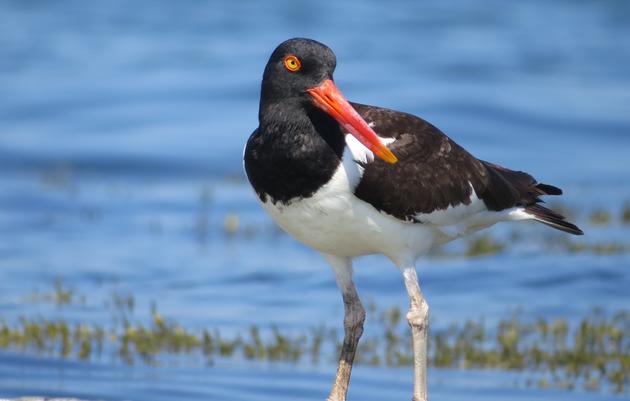Audubon Launches State's First American Oystercatcher Banding Program
Sharp-eyed bird watchers in Connecticut may notice something new about our state’s treasured American Oystercatchers (AMOY)—yellow leg bands. The birds aren’t making a fashion statement, this bling is part of Audubon Connecticut’s American Oystercatcher Banding Program, an exciting effort to help protect this species of conservation concern in Connecticut and throughout the Atlantic Flyway.
The primary goal of the program is to assess the movement patterns and survival rates of American Oystcercatchers, which are at risk due to low population size, limited habitat availability, and vulnerability to climate change and disturbance. This will be accomplished over several years (2018-2021) as birds are banded and then observed. The oystercatchers will be carefully captured by trained staff who then place a USGS (United States Geological Survey) metal incoloy band on the bottom section of a leg as well as an alphanumeric coded band on each upper leg to uniquely mark adults and juveniles (when their legs reach adult size). Different states use different color alphanumeric bands. Connecticut, Rhodes Island, and Massachusetts have been assigned yellow, while New York and New Jersey use orange.
Audubon is working with the Connecticut Department of Energy & Environmental Protection (CT DEEP) on the project. To band the birds, Audubon staff use decoys and recordings to lure the oystercatchers into a whoosh net for capture. The program team is very excited to be using decoys crafted by world championship carver and Connecticut resident Keith Mueller. When the birds are in range, the lightweight net is propelled through the air by bungies. The birds are quickly removed from the net, banded, and released. The bands do not harm or discomfort the birds and they serve as the identifying tool to track movement, behavior, and population levels.
“The key to the success of this program will be in the collection of observations or sightings through the American Oystercatcher Working Group,” says Corrie Folsom-O’Keefe of Audubon Connecticut. The Working Group is a collaboration between states along the Atlantic Coast that share banding data to analyze the migration and population of American Oystercatchers. Folsom-O’Keefe further explains “Because we historically do not know where most of the American Oystercatchers that nest in Connecticut go after the breeding season, the information gained from this program will be incredibly helpful in identifying the locations where the species stops during migration and lives in the winter.” Audubon will also gain a better understanding of movement patterns within the state and whether individuals return from year to year. Researchers, volunteers, bird watchers, and citizens who report their sightings will be providing critical data that will improve our knowledge of the ecology of oystercatchers and help advance the conservation of this vulnerable species.
To learn more about American Oystercatcher banding and how to identify a band and report a sighting, go online to amoywg.org/banding-re-sighting.
For questions, contact Corrie Folsom-O'Keefe, Audubon Connecticut Bird Conservation Programs Manager at cfolsom-okeefe@audubon.org or 203-405-9116.
Related
This Oystercatcher Couple Proves There’s No Wrong Way to Love
Banding has enabled us to track the seasonal love affair of this bird couple by observing their movements across the years.
American Oystercatcher Nest Survives Washout, and Other Firsts
Audubon Connecticut’s 2019 coastal field season saw many successes for this iconic shorebird species.
New Insights into Connecticut's American Oystercatcher Population
In just one year, a new banding program has already increased our understanding of the behavior and movements of Connecticut’s American Oystercatcher breeding population.
How you can help, right now
Get Involved
There are so many great ways you can get involved with Audubon Connecticut and make a difference for both the wildlife and the people who call Connecticut home.
Visit Our Centers
Connect with our nature centers in Greenwich, Sharon, and Southbury. Each unique center offers trails, educational resources, conservation opportunities, and more.
Support Us
Through land stewardship, science, education, and advocacy, Audubon Connecticut works across the state to preserve habitat and protect bird species that are of state, national, and global concern.






